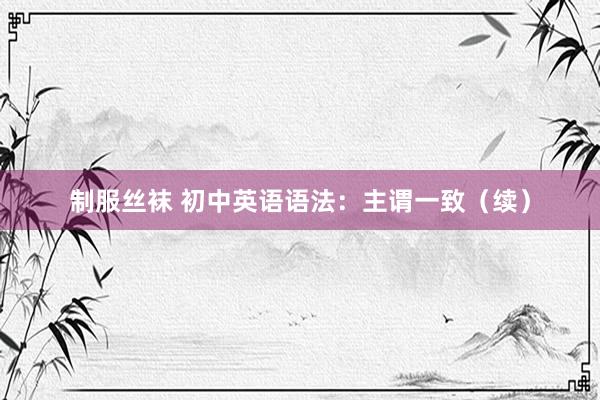
图片制服丝袜
3、就近一致的原则
指谓语动词用单数模样照旧用复数模样,取决于最围聚他的主语。
(1)由or, either…or…, whether ... or ..., neither…nor…, not only…but also…, not…but… 衔接两个名词或代词作东语时,字据就近原则决定谓语动词模样。
图片
1.Either my wife or I am going. 要么我爱妻去要么我去。
2.Not the students but I was wrong. 不是学生错了,而是我错了。
3.Neither she nor you have a dictionary. 她莫得字典,你也莫得。
4.Not only John but also his parents are coming. 不仅约翰,况且他的父母也皆来了。
5.Neither you, nor I, nor anyone else knows the answer. 你、我、任何东说念主皆不知说念谜底。
(2)there/here be句型be动词单复数取决于自后的主语。若是自后是由and衔接的两个主语,则应与围聚的阿谁主语保抓一致。
1.Here is the book you want.这即是你要的书。
2.Here are the boys I am looking for. 这些即是我正在寻找的男孩。
3.There is a book and three pens on the desk. 书桌上有一册书和三支钢笔。
4.There are two chairs and a desk in the room. 在房间里有两张椅子和一张书桌。
二 倒装句
英语句子的基本语序是比拟固定的,一般主语在前,谓语在后。但偶而因为语法结构的条款或由于修辞的条款,时时要窜改句子的当然语序,把一些本应置于主语之后的要素提前,咱们称这种语序为倒装语序。倒装语序又分为全部/饱胀倒装(若是谓语动词全部放在主语之前,这种语序称为饱胀倒装。)和部分倒装(若是只把助动词、面貌动词或系动词be放在主语之前,这种语序称为部分倒装。)。
1、So+系动词/助动词/面貌动词+主语。默示与上文中所述细则情况疏浚,句子属于部分倒装。
【缜密】若是对前边所说的事实加以细则时,用“So+主语+系动词/助动词/面貌动词”默示“确乎如斯”。前后两个句子的主语为合并个东说念主或物。
1.Peter is a worker, so is Jack. 彼特是一个工东说念主,杰克亦然。
2.---- Jack likes rice for lunch. 杰克午饭可爱吃米饭。 ----So do I. 我亦然。
3.---- Daming likes English. 大明可爱英语。---- So he does. 委果如斯。
4.---- Jack likes rice for lunch. 杰克午饭可爱吃米饭。---- So he does. 他确乎可爱。
2、Neither+系动词/助动词/面貌动词+主语。默示与上文中所述含糊情况疏浚,句子属于部分倒装。
Tom isn’t a doctor, neither am I. 汤姆不是一个大夫,我也不是。
---- Peter has never been to Japan. 彼得从未去过日本。---- Neither have I. 我也莫得去过。
3、含糊副词never, hardly, seldom, little, not等置于句首时,句子要部分倒装。
Hardly could he believe his own eyes. 他险些不可深信我方的眼睛。
4、“only+状语”置于句首时,句子要部分倒装。
【缜密】only后接状语从句时,从句的语序不可倒装。
1.Only in this way can you learn English well. 唯有效这种顺序,你能力学好英语。
2.Only when the war was over in 1918 was he able to get back home. 直到1918年干戈扬弃,他才重返家乡。
5、在以here, there, out, in, down, up, away等默示形状的副词发轫的句子中,若是主语是名词时,句子要饱胀倒装。因此谓语动词的模样由位于倒装句句尾的主语决定。如:Out rushed the children. 孩子们冲了出去。
1.There goes the bell. 铃响了。
2.Here is a flower. 这儿有一朵花。
【缜密】若是主语是东说念主称代词,则无谓倒装。如:Here you are. 给你。// Away he went. 他走了。
6、默示方针的介词短语置于句首时,句子要饱胀倒装。
In front of the school is the hospital. 学校的前边即是病院。
【缜密】介词短语在倒装句中要举座前移,不可终结。
7、以默示手艺的副词now, then携带的句子,谓语动词是come, begin, end, follow, be等时,句子要饱胀倒装。
飘雪影院在线神马影院Then came the workers. 接着来的是工东说念主。
【缜密】若是主语是东说念主称代词,则无谓倒装。如:Then he went. 接着他走了。
8、There be句型(饱胀倒装句)
(1)界说:There be 结构主要用以抒发“某时(某地)有某东说念主(某物)”。
(2)结构:“There be + 某物或某东说念主 + 某地或某时”。
there是携带词,莫得词义,在句中不充任任何要素,翻译时也不必译出;be是谓语动词;“某东说念主或某物”是句子的主语,主语在be的背面;“某地或某时”作句子的状语,多是介词短语。如:
There is a football under the chair. 椅子底下有一个足球。
携带语 谓语动词 主语 介词短语(某地)
(3)“There be”句型的主谓一致
① there be 结构中的谓语动词be在东说念主称和数上应与自后的主语保抓一致。主语是不可数名词或单数可数名词时用is,是复数时用are。
1.There is a flower in the bottle. 瓶里有一朵花。
2.There are some books on the desk. 桌子上有些书。
②当有两个或两个以上的名词作比肩主语时,be的模样则和第一个名词保抓一致(就近原则)。
1.There is a pen and two books on the desk. 课桌上有一枝钢笔和两本书。
2.There are two books and a pen on the desk. 课桌上有两本书和一枝钢笔。
3.There is a boy, a girl and two women in the house. 屋子里有一个男孩,一个女孩和两个妇女。
③ 另外,在述说句中为了强调地方,也可将介词短语置于句首。
1.In the tree there are five birds. 树上有五只鸟。
2.Under the tree there are two boys and a girl. 树下有两个男孩,一个女孩。
(4)There be句型与have的分袂与有关:
① 分袂点:there be默示“某地/时有某东说念主/物”,强调客不雅存在,不默示所属相干;have(has, had)默示“(某东说念主)领有某物”,强调所属相干。
There are some trees in front of the house. 房前有些树。Tom has many friends in China. 汤姆在中国有很多一又友。
② 疏浚点:在默示结构上的“含有”、“包括”、“存在”的含义时,既不错用there be 句型,也不错用have(has) 来默示。
A week has seven days. =There are seven days in a week. 一个星期有七天。
There are many long rivers in China.=China has many long rivers. 中国有很多长河。
(5)There be 句型的含糊句、一般疑问句、突出疑问句和反意疑问句
① 含糊句:there be的含糊式常常在be后加not或no组成(在白话中be常常与not缩写在整个)。若是句中有some一般要造成any。缜密not和no的不同:not是副词,no为刻画词,not a/an/any + n. 相称于no+ n.。:
There are some pictures on the wall. →There aren’t any pictures on the wall. =There are no pictures on the wall.
There is a bike behind the tree. →There isn’t a bike behind the tree. =There is no bike behind the tree.
② 一般疑问句绝顶答语:
把be提到there前,首字母大写,句末用问号即可。其细则答语是Yes, there is / are;含糊答语为No, there isn’t / aren’t。但同期要缜密:当细则句中有some时,要将其改为any(含糊变化也同样)。望望底下的句子是如何“救一火图存”的。
There is some water on Mars. → Is there any water on Mars?
There are some fish in the water. →Are there any fish in the water?
---- Are there two cats in the tree? ---- Yes, there are. (No, there aren’t.)
---- Is there a flower in the bottle? ---- Yes, there is. (No, there isn’t.)
③ 突出疑问句绝顶回话:
A. 发问there be句型的主语(包括主语前的修饰语),当主语是东说念主时,用“Who’s+介词短语?”;当主语是物时,用“What’s+介词短语?”。
【缜密】不管主语是单数照旧复数皆用is(回话时却要字据本体情况来决定)。
There is a little girl in the room. →Who is in the room?
There are some birds in the tree. →What’s in the tree? // There are many things over there. →What’s over there?
B. 发问there be句型背面的地方状语时,用“where is/are+主语?”
There are four children on the playground. →Where are the four children?
There is a car in the street. →Where is the car? // There is a computer on the desk. → Where is the computer?
C. 发问名词(主语)前的数目时,一般有两种句型结构:
▲How many+复数名词+are there+介词短语? 如:
There are five bananas in the box? →How many bananas are there in the box?
▲How much+不可数名词+is there+介词短语?如:
There is some milk in the bottle. →How much milk is there in the bottle?
④ There be 句型的反意疑问句:反意疑问句的附加部分诓骗there。
There is some orange in the glass, isn’t there? 杯子里有桔汁,是吗?
There are no letters in the mailbox, are there? 邮筒里莫得信件,是吗?
There will be a new hospital nearby, won’t there? 隔邻要建一家新病院,是吗?
(6)There be 句型的时态:There be 句型中动词be不错有一般现时时、一般夙昔时、来日时和完成时。
There is no harm in trying. 不妨一试。
There will be a fine day tomorrow. 翌日将是一个好天。
There were fabulous wildflowers in the hills last spring. 前年春天,山中有极好意思的野花。
There have been several private schools in our area this year. 本年制服丝袜,咱们这里也曾有好几所私立学校了。
本站仅提供存储管事,总共内容均由用户发布,如发现存害或侵权内容,请点击举报。
